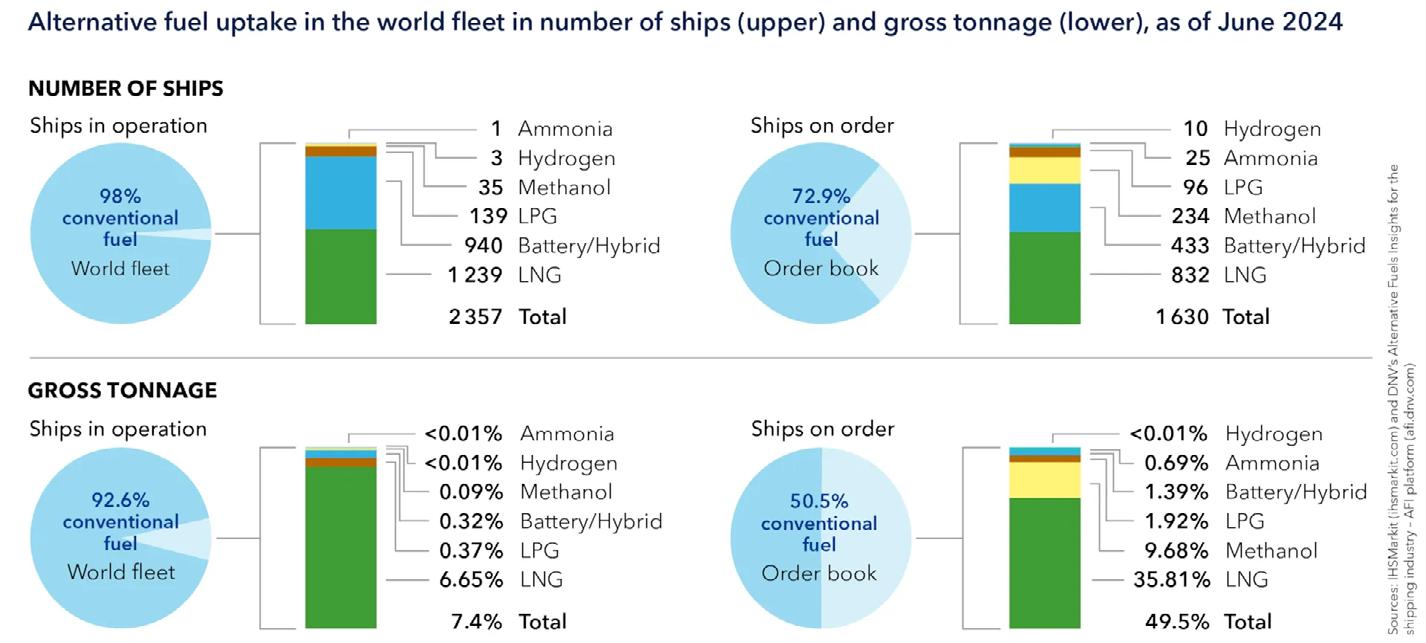
9 minute read
Unlocking the code. Strategies for meeting upcoming decarbonization targets
by Eirik Ovrum, Principal Consultant in Maritime Environmental Technology, DNV
Driven by EU regulations and the International Maritime Organization’s (IMO) goals, the shipping industry is maintaining its course for decarbonization but making slow headway toward an alternativefueled fleet. DNV’s latest Maritime Forecast to 2050 (MF2050) report confirms our previous finding that carbon-neutral fuels will remain expensive and in limited supply for the near future. As such, it recommends more realistic decarbonization measures for shipping over the next decade.
Maritime’s strategic focus for decarbonization in the short- to medium-term should be on operational and technical solutions to improve energy efficiency and otherwise reduce greenhouse gas (GHG) emissions. MF2050 evaluates the decarbonization challenges and the toolbox of technologies for designing and retrofitting ships to future-proof them.
Shipping cannot meet 2030 targets by using carbon-neutral fuels
The destination and waypoints for shipping’s energy transition are set by the IMO goals: a 20% emission reduction by 2030, a 70% reduction by 2040, and full-scale decarbonization by or around mid-century (all compared with 2008 levels).
Adding insight into how much carbon-neutral fuels can drive the transition to 2030 and beyond, MF2050 assesses their existing and planned production. Factoring in the probability of plans becoming reality, it estimates potential ‘High’ and ‘Low’ levels of fuel output for each year.
The report estimates the cumulative capacity of ongoing or announced carbon-neutral fuel production capacities for 2030 to be 44-to-63 million tonnes of oil equivalent (mtoe). Maritime demand in 2030 is forecasted at 7.0-to-48mtoe. Depending on the actual demands, shipping would need 10-to-100% of the actual available carbon-neutral fuels to reach the IMO targets. But our modelling results show it will be tough for shipping to source its needs if production follows the ‘Low’ trajectory. Even if production is ‘High,’ other decarbonizing industries, such as aviation and road transport, will compete for these fuels.
A role for OCC
On-board carbon capture (OCC) is attracting interest because it could delay the need for carbon-neutral fuels by removing carbon dioxide (CO2) from conventional fuels and technologies. OCC could be technically and economically feasible depending on carbon pricing and the availability of value chains and infrastructure for carbon use or permanent storage, a recent DNV white paper concluded . The scarcity and high cost of carbon-neutral fuels could potentially support a stronger business case for OCC.
MF2050 assesses the value chain required and presents the status of and outlook for carbon storage, suggesting how OCC could become viable for vessels on busy shipping routes. Based on the ‘High’ and ‘Low’ trajectories of CO2 storage capacity for all industries and purposes (excluding enhanced oil recovery), the report sees 47-to-67 million tonnes of CO2 capacity being available in 2030 compared with shipping’s estimated storage demand of 4.0-to-76mt CO2 .
That said, out of the 96 planned projects for dedicated CO2 storage, less than 10 have reached the final investment stage (and most are still concepts). The uncertainties weigh against installing OCC on ships immediately, but in our exploratory scenarios for achieving decarbonization goals, OCC emerges as an important technology for GHG reduction after 2030.
Maritime clearly needs to work with developers to secure carbon-neutral fuel supply, likewise CO2 storage, to maximize the longer-term potential of these technologies for decarbonizing shipping. However, the inescapable message is that energy-efficiency measures are essential for achieving fuel and emission reductions to at least meet the earlier IMO 2030 targets and ensure profitability into the 2030s and 40s.
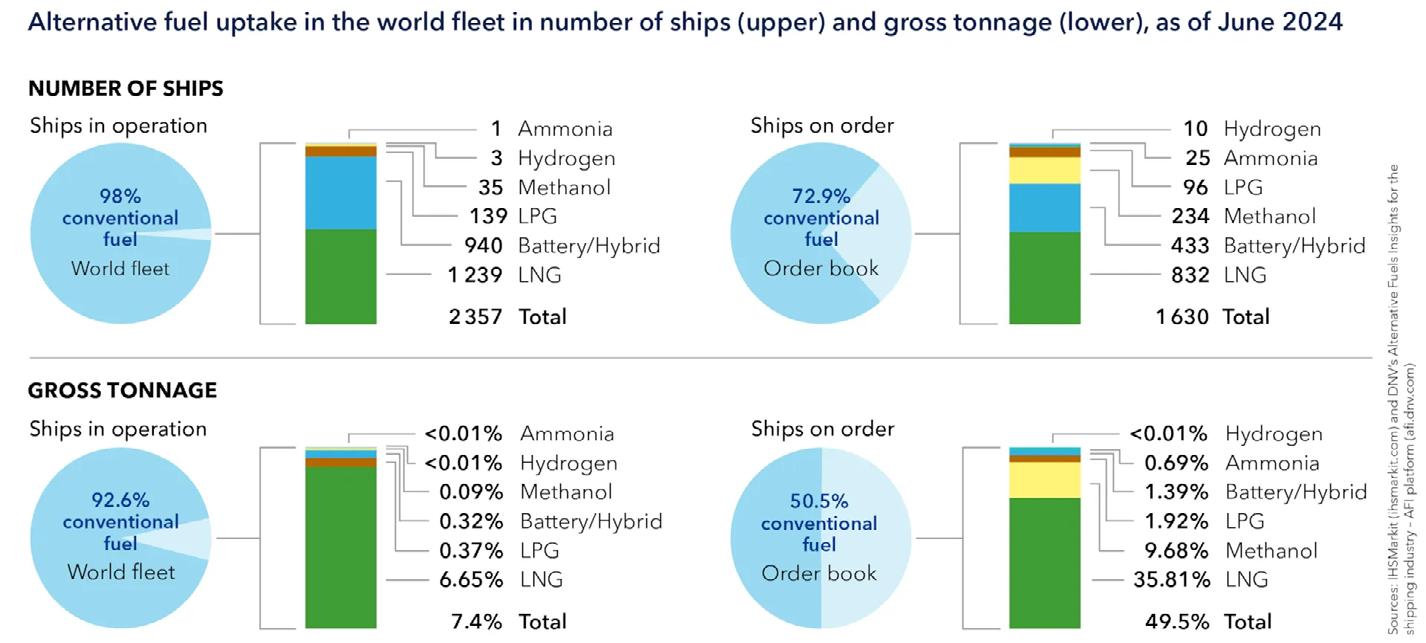
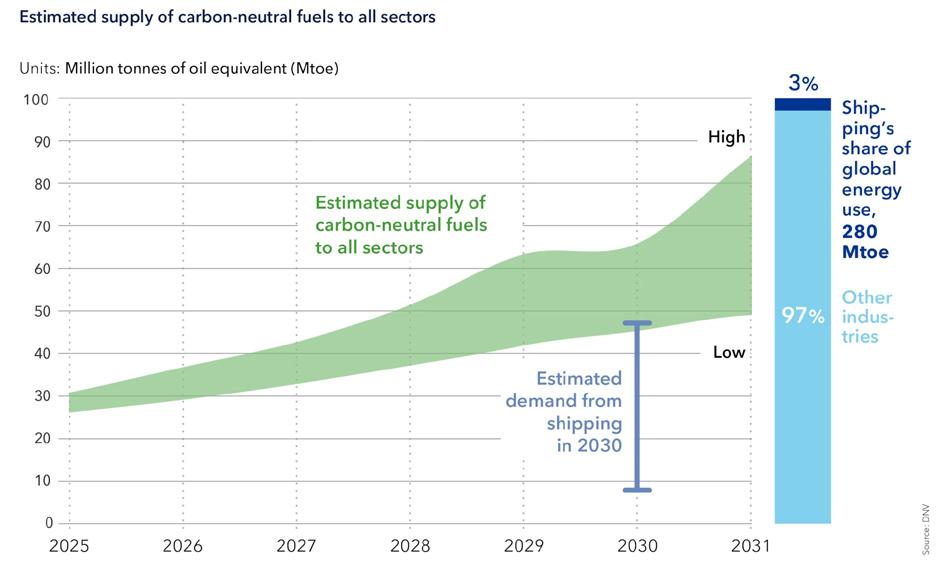
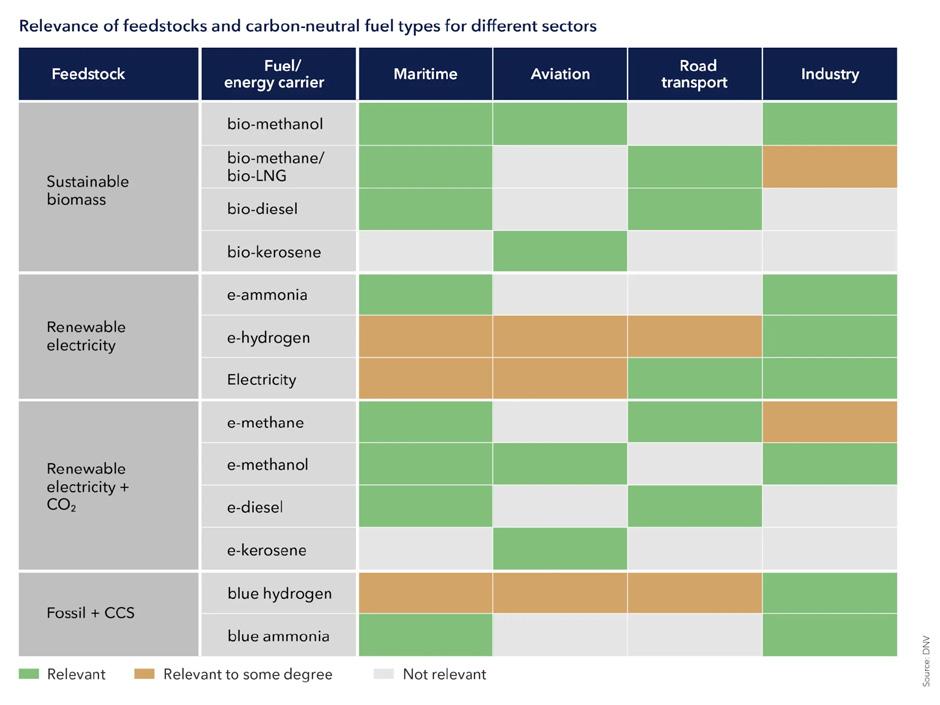
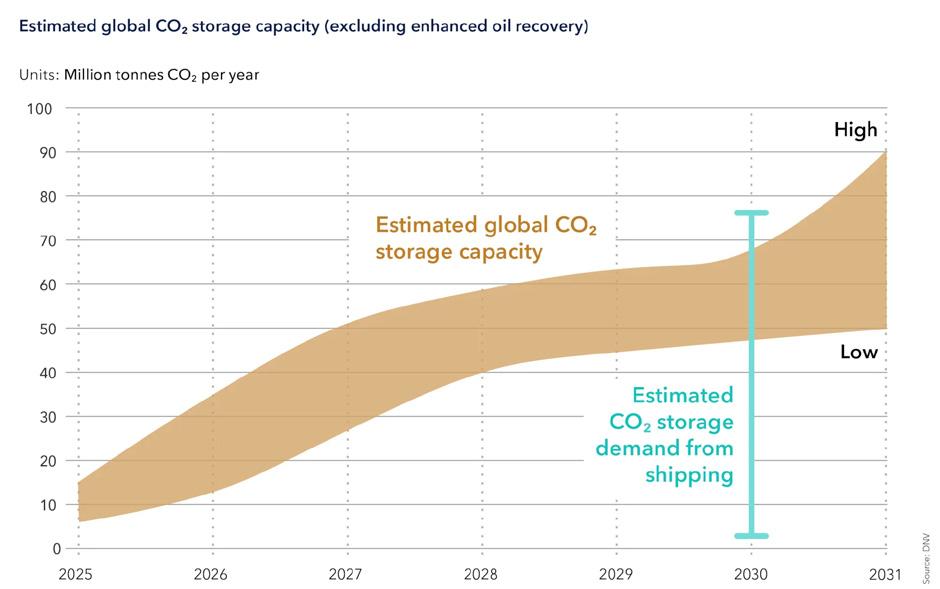
Buying into energy efficiency for sustained competitiveness
Two-thirds of the energy used to produce propulsion is lost. MF2050 outlines the options to reduce these losses through energy efficiency, thus providing cost-efficient and predictable pathways to emission reduction. It estimates that operational and technical energy-efficiency measures can reduce fuel consumption by 4-to-16% by 2030, contributing to emission reduction.
Energy efficiency provides cost-efficient, predictable pathways to emission reduction. The business cases for energy-saving technologies may now be better when evaluated against the cost of alternative fuels. Energy efficiency can give shipowners a competitive edge to operate profitably into the 2030s-40s.
MF2050 finds 72 waste heat recovery systems on order, twice the number currently installed. Some 166 air lubrication systems are operating today, with 280 on order for newbuilds. Around 90 large vessels could have wind-assisted propulsion systems by 2025, nearly triple the tally of 31 at the start of 2024.
Shore power vs electrofuels
Around 7.0% of ships’ energy consumption is in port. The resultant emissions can be abated using power from the shore. The degree of abatement, however, depends on the carbon footprint of the local electricity supply – whether it comes from renewables such as wind or solar.
MF2050 compares energy losses from direct use of shore power and when producing electricity from onboard generators running on fossil fuels or the electrofuel e-ammonia. The energy losses are used to calculate the total GHG intensity per usable energy unit. The calculations consider power-grid GHG intensity for different countries and regions and from coal-fired power generation.
One key finding is that the well-to-wake (WtW) emissions from onboard power production in a marine gas oil-fuelled generator set exceed many countries’ average GHG power grid intensity. Consequently, using shore power can lead to efficient WtW emission reductions. Another finding is that to positively affect the vessel’s GHG emissions, electrofuels must be produced using electricity with very low GHG intensity.
Shorter voyages open door to recharging ship batteries in port
More than 900 ships operate with batteries for hybrid power systems or that can be charged by shore power, according to DNV’s Alternative Fuels Insight. MF2050 reviews what influences investment in such onboard battery systems can have. For example, a ship making many short-duration voyages will have more chances to charge batteries in port than one sailing longer journeys. Looking at ships above 400 of gross tonnage in 2023, it selects those using 80% of their fuel (when out of port) on short voyages, which would allow frequent battery charging and for batteries to cover ‘a substantial amount’ of a ship’s annual energy needs. MF2050 then evaluates how much fuel is consumed on these short voyages.
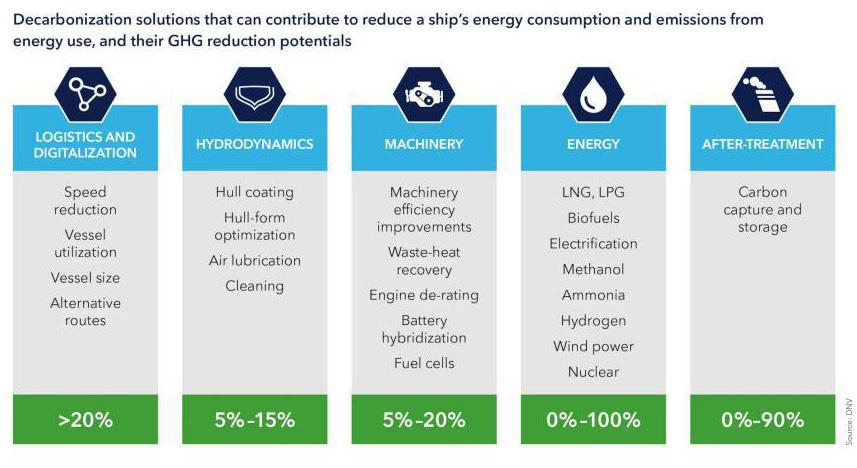
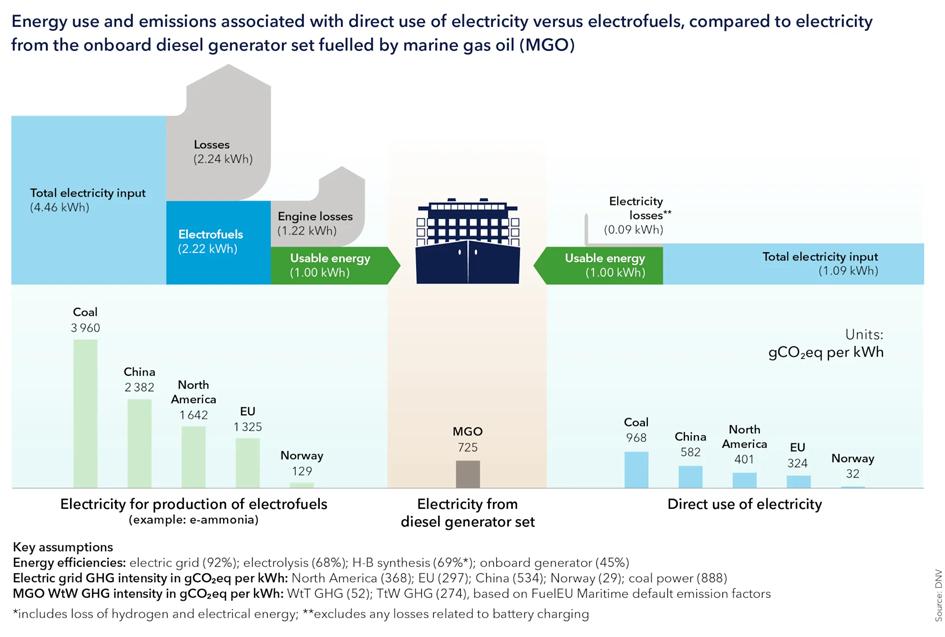
Evaluating the potential for plug-in hybridization
The 4,000 ships using 80% of their voyage energy consumption on trips shorter than 24 hours consume 6.0mtoe per year in energy while sailing on these short trips, equivalent to 2.4% of the world fleet energy use. The report finds that increasing voyage duration to 72 hours results in 8,000 ships using 80% or more of their voyage energy on short voyages –6.2% of world fleet energy use.
We conclude that the potential for plug-in hybridization can be boosted by modifying current operational patterns or by building vessels specifically for shorter voyages. In addition, better battery and charging technologies can improve the energy efficiency of on-board power systems based on internal combustion engines. Greater efficiency, in turn, boosts the business case for investing in on-board batteries for plug-in hybridization.
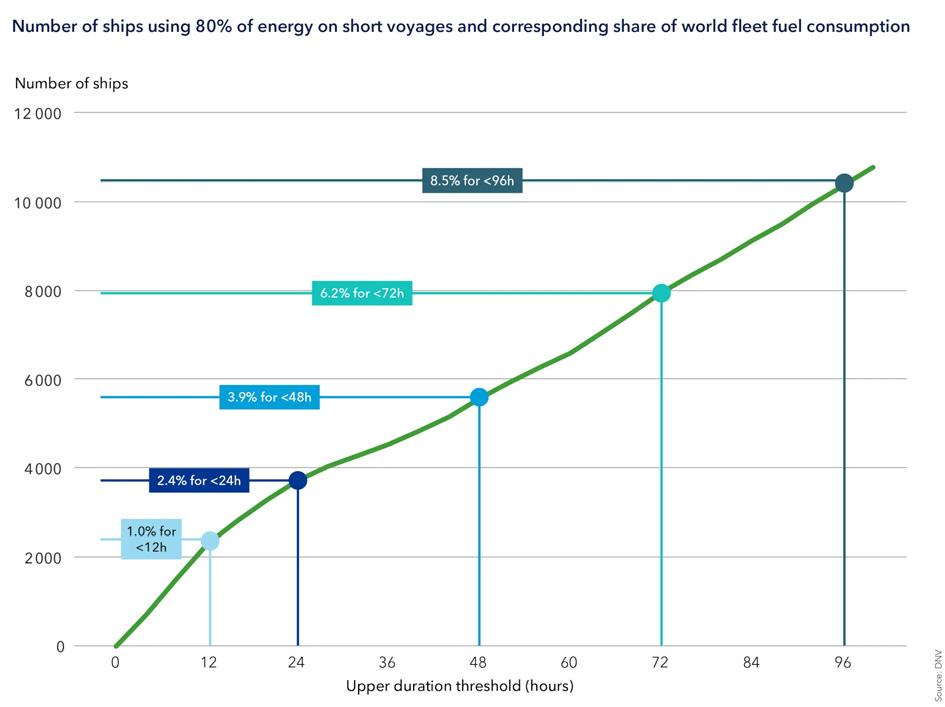
Can nuclear propulsion support ship decarbonization?
Building on a case study from last year’s edition, the 2024 report updates and elaborates on factors relevant to answering this question. It discusses whether small modular reactors could be widely used in the global merchant fleet, potentially creating opportunities for standardization and joint development in technology choice, regulation, and safety follow-up for onshore reactors. If commercial, technical, and political barriers can be overcome, there could be an opportunity for a nuclear reactor program dedicated to shipping to accelerate the development of nuclear power overall.
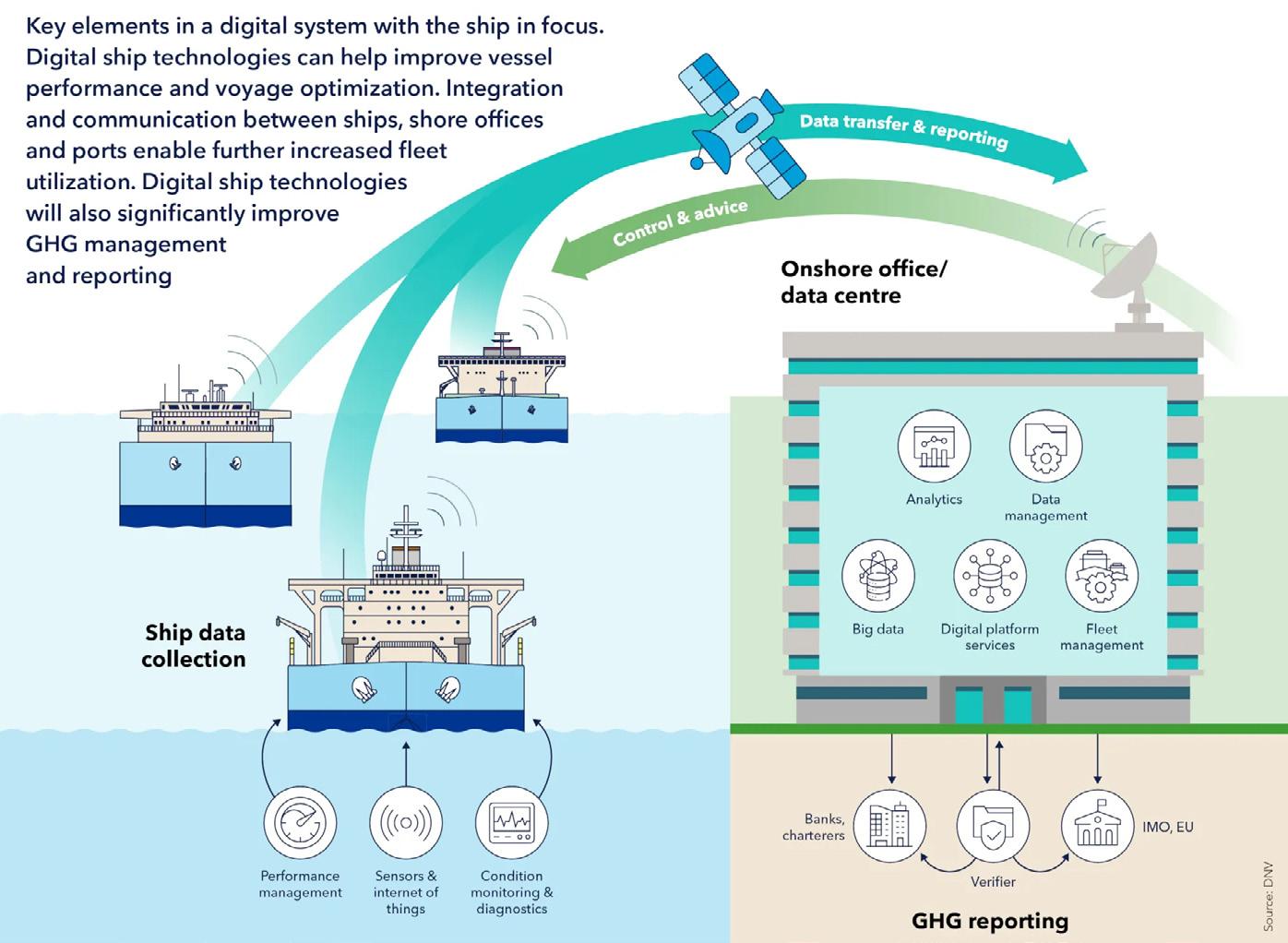
How digitalization drives energy efficiency
MF2050 extensively analyzes how digitalization can enable operational efficiency and smooth contractual arrangements, as well as facilitate reliable, flexible, and dynamic emission reporting.
Recent advancements in digital tools –like artificial intelligence, machine learning, the Internet of Things, and computer simulations – have greatly improved and facilitated the reduction of the carbon footprint of shipping operations. These technologies fall into four categories: sensing, enabling, data handling, and decision-making. When interacting, these can help the shipping industry to fully leverage digitalization for better efficiency and sustainability.
Advanced simulation and optimization models can help design next-generation energy-efficient ships. Real-time data can facilitate truly integrated maritime networks. For example, the container sub-sector could cut energy use by up to 14.2% by coordinating just-in-time arrivals, according to a study commissioned by the IMO-Norway GreenVoyage2050’s Global Industry Alliance to Support Low Carbon Shipping.
Digitalization can also make vessel performance more transparent, showing seafarers how they can directly impact decarbonization. Additionally, green and digital shipping corridor projects with complete logistics chains could pilot scalable optimization solutions enabled by digital tools.
Examples in the report emphasize how emission reporting, new contractual arrangements, and regulatory mechanisms, such as pooling and book & claim, depend on transparent, reliable data backed up by a trusted source. Exploiting all the decarbonization possibilities from digitalization requires data quality and reliability to create trust. Digital tools like DNV’s Emissions Connect can help to build that trust across shipping.
Paying the price for decarbonization
Beyond the fuels, technologies, and operational measures covered, MF2050 stresses that successful maritime decarbonization requires progressive, goal-orientated regulatory frameworks. This is highlighted by modelling the impact of regulations such as FuelEU Maritime’s pooling mechanism, which will support a switch to fleet-wide fuel strategies and de-risk investing in alternative-fueled vessels.
Smart decision-making and strategic investments are needed today to lay the foundations for future emission reductions. Using an updated version of our GHG Pathway Model, MF2050 pragmatically assesses the options to assist maritime stakeholders in unlocking the decarbonization code.
--
DNV is the world’s leading classification society and a recognized advisor for the maritime industry. We enhance safety, quality, energy efficiency and environmental performance of the global shipping industry – across all vessel types and offshore structures. We invest heavily in research and development to find solutions, together with the industry, that address strategic, operational, or regulatory challenges. Visit dnv.com/maritime for more information.








